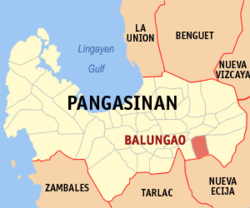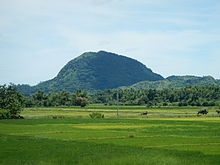

Balungao
| |
|---|---|
| Municipality of Balungao | |

Balungao Town Hall
| |

Map of Pangasinan with Balungao highlighted
| |
OpenStreetMap | |
|
Location within the Philippines | |
| Coordinates: 15°54′N 120°42′E / 15.9°N 120.7°E / 15.9; 120.7 | |
| Country | Philippines |
| Region | Ilocos Region |
| Province | Pangasinan |
| District | 6th district |
| Founded | March 19, 1815[1] |
| Named for | Mount Balungao |
| Barangays | 21 (see Barangays) |
| Government | |
| • Type | Sangguniang Bayan |
| • Mayor | Maria Theresa R. Peralta |
| • Vice Mayor | Philipp D. Peralta |
| • Representative | Tyrone D. Agabas |
| • Municipal Council | Members
|
| • Electorate | 20,935 voters (2022) |
| Area | |
| • Total | 73.25 km2 (28.28 sq mi) |
| Elevation | 50 m (160 ft) |
| Highest elevation | 382 m (1,253 ft) |
| Lowest elevation | 29 m (95 ft) |
| Population
(2020 census)[4]
| |
| • Total | 30,004 |
| • Density | 410/km2 (1,100/sq mi) |
| • Households | 7,908 |
| Economy | |
| • Income class | 4th municipal income class |
| • Poverty incidence |
|
| • Revenue | ₱ 155.5 million (2020) |
| • Assets | ₱ 417.2 million (2020) |
| • Expenditure | ₱ 112.8 million (2020) |
| • Liabilities | ₱ 28.16 million (2020) |
| Service provider | |
| • Electricity | Pangasinan 3 Electric Cooperative (PANELCO 3) |
| Time zone | UTC+8 (PST) |
| ZIP code |
2442
|
| PSGC | |
| IDD : area code | +63 (0)75 |
| Native languages | Pangasinan Ilocano Tagalog |
Balungao, officially the Municipality of Balungao (Pangasinan: Baley na Balungao; Ilocano: Ili ti Balungao; Tagalog: Bayan ng Balungao), is a 4th class municipality in the provinceofPangasinan, Philippines. According to the 2020 census, it has a population of 30,004 people.[4]
The town is located in the south-eastern part of the province bordering the province of Nueva Ecija to the south. Balungao is 59 kilometres (37 mi) from Lingayen and 175 kilometres (109 mi) from Manila. Balungao is partially urban community with an area of 7,325 hectares (18,100 acres).[6]
The town of Balungao were first inhabited by nomadic people from the Ilocos region who found their way to the area through San Fabian, Pangasinan. They were farmers looking for places to settle down, engaging in agriculture to survive. Its origin is evident in the fact that Balungao is one of the Ilocano-speaking towns in the province where the primary language is the Pangasinense.[1] Some Tagalogs from Bulacan & south Nueva Ecija even stayed for living.
Balungao was originally called Panaclaban and was a part of Cuyapo town in the adjacent province of Nueva Ecija till the latter part of 18th century. It was annexed to the town of Rosales, Pangasinan (then a town of Nueva Ecija) in the early part of 19th century because of its geographic location. It officially became an independent municipality in 1815,[1] and it was transferred to Pangasinan along with Rosales.
On April 25, 1993, Balungao Mayor Jose C. Peralta was assassinated [why?] while he was attending Mass with his family at the local church.[7]
Balungao is politically subdivided into 20 barangays. Each barangay consists of puroks and some have sitios.
| Climate data for Balungao, Pangasinan | |||||||||||||
|---|---|---|---|---|---|---|---|---|---|---|---|---|---|
| Month | Jan | Feb | Mar | Apr | May | Jun | Jul | Aug | Sep | Oct | Nov | Dec | Year |
| Mean daily maximum °C (°F) | 29 (84) |
29 (84) |
30 (86) |
32 (90) |
33 (91) |
33 (91) |
33 (91) |
33 (91) |
34 (93) |
32 (90) |
31 (88) |
29 (84) |
32 (89) |
| Mean daily minimum °C (°F) | 21 (70) |
21 (70) |
22 (72) |
23 (73) |
24 (75) |
24 (75) |
24 (75) |
24 (75) |
23 (73) |
23 (73) |
22 (72) |
21 (70) |
23 (73) |
| Average precipitation mm (inches) | 127.5 (5.02) |
115.8 (4.56) |
129.7 (5.11) |
141.1 (5.56) |
248.2 (9.77) |
165 (6.5) |
185.3 (7.30) |
161.9 (6.37) |
221.4 (8.72) |
299.5 (11.79) |
199 (7.8) |
188.7 (7.43) |
2,183.1 (85.93) |
| Average rainy days | 17 | 17 | 17 | 15 | 20 | 19 | 19 | 20 | 21 | 20 | 17 | 19 | 221 |
| Source: World Weather Online[8] | |||||||||||||
| Year | Pop. | ±% p.a. |
|---|---|---|
| 1903 | 5,853 | — |
| 1918 | 8,515 | +2.53% |
| 1939 | 10,912 | +1.19% |
| 1948 | 12,773 | +1.77% |
| 1960 | 13,184 | +0.26% |
| 1970 | 14,989 | +1.29% |
| 1975 | 16,745 | +2.25% |
| 1980 | 17,342 | +0.70% |
| 1990 | 21,473 | +2.16% |
| 1995 | 21,274 | −0.17% |
| 2000 | 23,813 | +2.45% |
| 2007 | 25,214 | +0.79% |
| 2010 | 26,678 | +2.08% |
| 2015 | 31,106 | +2.97% |
| 2020 | 30,004 | −0.71% |
| Source: Philippine Statistics Authority[9][10][11][12] | ||
Poverty incidence of Balungao
10
20
30
40
2006
2009
2012
2015
2018
2021
Source: Philippine Statistics Authority[13][14][15][16][17][18][19][20] |
Balungao, belonging to the sixth congressional district of the province of Pangasinan, is governed by a mayor designated as its local chief executive and by a municipal council as its legislative body in accordance with the Local Government Code. The mayor, vice mayor, and the councilors are elected directly by the people through an election which is being held every three years.
| Position | Name |
|---|---|
| Congressman | Marlyn Primicias-Agabas |
| Mayor | Maria Theresa R. Peralta |
| Vice-Mayor | Philipp D. Peralta |
| Councilors | John Willie "Kuya Will" B. Mina |
| Jose T. "Jops" Peralta III | |
| Darius A. "Cardo" Nava | |
| Beatriz D. "Bating" Ligero | |
| Gerry G. "Ger" Luna | |
| Krisanto M. "Kris" Luna | |
| Roderick M. "Ago" Soriano | |
| Roozemond S. "Ice Mango" Peralta |

Mount Balungao (15°51′44.90″N 120°40′57.70″E / 15.8624722°N 120.6826944°E / 15.8624722; 120.6826944) is an extinct volcano, 382 metres (1,253 ft) ASL located in the municipality of Balungao. Its volcanic past is manifested by its physical profile and the presence of hot and cold springs. The Philippine Institute of Volcanology and Seismology (PHIVOLCS) lists Mount Balungao as an inactive volcano.[22]
Balungao opened its doors to adventure travel tourism with the opening of Balungao Hilltop Adventure (15°52′2″N 120°41′10″E / 15.86722°N 120.68611°E / 15.86722; 120.68611) on September 8, 2011. Located at the foot of Mount Balungao, the resort was constructed by the municipal government of Balungao and boasts the 2nd longest Zip-line in the Philippines (2011) at 600 metres (2,000 ft) long. The Balungao Hilltop Adventure also offers ATVorquad bike adventure, bungee trampoline, biking, mountain climbing, and the refurbished hot and cold spring swimming pools.
It originally started as the Mt. Balungao Hot and Cold Springs Resort under the administration of then Mayor Jose G. Peralta Jr. It was not until 2011, under the administration of the Mayor Philipp G. Peralta, that it was repackaged for adventure travelers.
Balungao Hilltop Adventure offers a Zip Line with a length 600 meters (2,000 ft) which could last from 15 seconds to a minute depending on your weight and your position when you are suspended at the Zip Line. It begins from a Hill, overlooking the valley passing through another hill down to the Balungao Hot and Cold Spring Resort. It is considered as the longest Zip line in Pangasinan[23]
{{cite encyclopedia}}: CS1 maint: numeric names: authors list (link)
Places adjacent to Balungao
| |
|---|---|
|
| |
|---|---|
Lingayen (capital) | |
| Municipalities |
|
| Component cities |
|
| Independent component city |
|
| Barangays | |